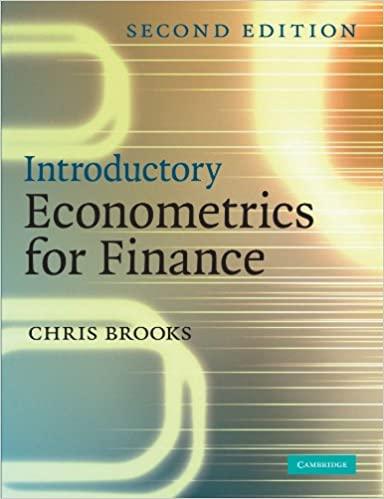(a) Briefly explain any difference you perceive between the characteristics of macroeconomic and financial data. Which of...
Question:
(a) Briefly explain any difference you perceive between the characteristics of macroeconomic and financial data. Which of these features suggest the use of different econometric tools for each class of data?
(b) Consider the following autocorrelation and partial autocorrelation coefficients estimated using 500 observations for a weakly stationary series, yt :
Lag acf pacf 1 0.307 0.307 2 −0.013 0.264 3 0.086 0.147 4 0.031 0.086 5 −0.197 0.049 Using a simple ‘rule of thumb’, determine which, if any, of the acf and pacf coefficients are significant at the 5% level. Use both the Box–Pierce and Ljung–Box statistics to test the joint null hypothesis that the first five autocorrelation coefficients are jointly zero.
(c) What process would you tentatively suggest could represent the most appropriate model for the series in part (b)? Explain your answer.
(d) Two researchers are asked to estimate an ARMA model for a daily USD/GBP exchange rate return series, denoted xt . Researcher A uses Schwarz’s criterion for determining the appropriate model order and arrives at an ARMA(0,1). Researcher B uses Akaike’s information criterion which deems an ARMA(2,0) to be optimal. The estimated models are A : ˆxt = 0.38 + 0.10ut−1 B : ˆxt = 0.63 + 0.17xt−1 − 0.09xt−2 where ut is an error term.
You are given the following data for time until day z (i.e. t = z)
xz = 0.31, xz−1 = 0.02, xz−2 = −0.16 uz = −0.02, uz−1 = 0.13, uz−2 = 0.19 Produce forecasts for the next 4 days (i.e. for times z +1, z +2, z + 3, z + 4) from both models.
(e) Outline two methods proposed by Box and Jenkins (1970) for determining the adequacy of the models proposed in part (d).
(f) Suppose that the actual values of the series x on days z +1, z +2, z +3, z +4 turned out to be 0.62, 0.19, −0.32, 0.72, respectively.
Determine which researcher’s model produced the most accurate forecasts.
AppendixLO1
Step by Step Answer:






